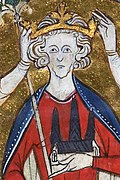Top Qs
Timeline
Chat
Perspective
List of monarchs in Britain by length of reign
From Wikipedia, the free encyclopedia
Remove ads
The following is a list, ordered by length of reign, of the monarchs of the United Kingdom of Great Britain and Northern Ireland (1927–present), the United Kingdom of Great Britain and Ireland (1801–1922), the Kingdom of Great Britain (1707–1801), the Kingdom of England (871–1707), the Kingdom of Scotland (878–1707), the Kingdom of Ireland (1542–1800), and the Principality of Wales (1216–1542).

Queen Elizabeth II became the longest-reigning monarch in British history on 9 September 2015 when she surpassed the reign of her great-great-grandmother Queen Victoria.[1][2] On 6 February 2017, she became the first British monarch to celebrate a Sapphire Jubilee, commemorating 65 years on the throne. On 6 February 2022, Elizabeth II became the first British monarch to reign for 70 years, and large-scale celebrations for her Platinum Jubilee occurred on 2 to 5 June. At her death aged 96 later that year, she had reigned for 70 years and 214 days.[3]
Remove ads
Ten longest-reigning British monarchs
Summarize
Perspective
These are the ten longest-reigning monarchs in the British Isles for whom there is reliable recorded evidence. This list excludes Constantine II of Scotland who ruled for approximately 43 years from circa 900 to 943.
Remove ads
Complete list of the unitary monarchy
Summarize
Perspective
On 1 May 1707, under the Acts of Union 1707, the Kingdom of England united with the Kingdom of Scotland as the Kingdom of Great Britain. Then, on 1 January 1801, the Kingdom of Great Britain united with the Kingdom of Ireland to become the United Kingdom of Great Britain and Ireland, becoming the United Kingdom of Great Britain and Northern Ireland by Act of Parliament in 1927[4] following the creation of the Irish Free State in 1922.
Remove ads
Complete list of the kingdoms
Summarize
Perspective
England

Includes English monarchs from the installation of Alfred the Great as King of Wessex in 871 to Anne (House of Stuart) and the Acts of Union on 1 May 1707, when the crown became part of the Kingdom of Great Britain.
Scotland
Includes Scottish monarchs from the installation of Kenneth I (House of Alpin) in 848 to Anne (House of Stuart) and the Acts of Union on 1 May 1707, when the crown became part of the Kingdom of Great Britain.
Remove ads
List of the Principalities
Summarize
Perspective
Gwynedd (incomplete list)
This section needs expansion. You can help by adding to it. (December 2019) |
The Principality (or Kingdom) of Gwynedd (5th century–1216), located in northwest Wales, was one of the most prominent early medieval Welsh kingdoms. Its rulers were often acclaimed as "King of the Britons," symbolizing their influence over other Welsh territories and their resistance to external threats. Gwynedd faced repeated challenges, including civil wars, Saxon incursions, and Norman invasions, which gradually eroded its dominance. In 1216, it transitioned into the Principality of Wales, although the title "Prince of Wales" was not formally adopted until the 1240s under the leadership of Llywelyn ap Gruffudd, also known as Llywelyn the Last.
Gwynedd’s heartland was the mountainous region of Snowdonia, which provided natural defenses and contributed to its resilience against invaders. The kingdom played a central role in preserving Welsh identity, language, and culture during a period of significant upheaval in Britain.
Gwynedd’s political and military structure helped shape the foundations of later Welsh governance. Its rulers, particularly under the House of Aberffraw, established enduring principles of leadership and unity that influenced medieval Welsh law and identity. As historian R. R. Davies notes in The Age of Conquest: Wales 1063–1415, Gwynedd stood as “the nucleus of Welsh political life,” embodying both resistance and renewal amid centuries of external pressure.[6]
Wales
This section needs expansion. You can help by adding to it. (December 2019) |
The Principality of Wales (1216–1542) was a client state of England for much of its history, except for brief periods when it was de facto independent under a Welsh Prince of Wales (see House of Aberffraw). From 1301 it was first used as a title of the English (and later British) heir apparent. The Laws in Wales Acts 1535 and 1542 formally incorporated all of Wales within the Kingdom of England.
Remove ads
See also
Notes
- James VI, King of Scots, became James I, King of England, in 1603.
- Monarch's total length of reign is the sum of the two reigns displayed.
- Charles II King of England and King of Scots reigned concurrently from 29 May 1660 to 6 February 1685.
- Charles I was King of England and King of Scots concurrently.
- William of Orange became William III, King of England, on 13 February 1689 and William II, King of Scots, on 11 May 1689.
- Mary II became Queen of England on 13 February 1689 and Queen of Scots on 11 May 1689.
- Anne, Queen of England and Scotland, became Queen of Great Britain on 1 May 1707.
- James was James II, King of England, and James VII, King of Scotland, concurrently.
Additional
^N.S. Over the course of George II's life, two calendars were used: the Old Style Julian calendar (O.S.) and the New Style Gregorian calendar (N.S.). Before 1700, the two calendars were 10 days apart. Hanover switched from the Julian to the Gregorian calendar on 19 February/1 March 1700. Great Britain switched on 3/14 September 1752.
^N.S. Over the course of George II's life, two calendars were used: the Old Style Julian calendar (O.S.) and the New Style Gregorian calendar (N.S.). Before 1700, the two calendars were 10 days apart. Hanover switched from the Julian to the Gregorian calendar on 19 February/1 March 1700. Great Britain switched on 3/14 September 1752.
Remove ads
References
Wikiwand - on
Seamless Wikipedia browsing. On steroids.
Remove ads







